As it continues to mark its 10th anniversary with special exhibitions and events, the Aga Khan Museum in Toronto is exhibiting new and archival photography that points to a much longer history — ten centuries, not just ten years.
In fact, visitors can take a kind of smart walk – one that blends science, math and art – back to the 11th century to see and learn more about a unique form of Islamic architecture known as muqarnas. Visually intoxicating, intellectually stimulating, muqarnas make an immediate connection with history, culture, and human aspiration; looking at them might also lead one to think about fractal geometry, computer graphics, and endlessly scalable technology.
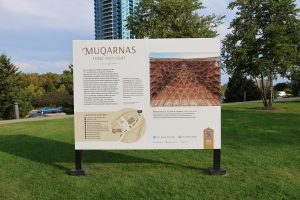
The introductory panel from Muqarnas: Form and Light, mounted outdoors in the Aga Khan Park in Toronto. Image courtesy Aga Khan Museum.
Muqarnas: Form and Light is a free, outdoor exhibition that places several large, eye-catching photo display panels throughout the Aga Khan Park adjacent to the Museum building itself. Each panel highlights a beautiful digital image of architectural wonders from across the Muslim world, including mosques, monuments, and other domed buildings. The images were captured by Glenn McArthur, a Toronto-based photographer, author, and arts educator.
(The exhibition also includes archival images of now-lost or destroyed muqarnas, sourced thanks to a partnership between the Aga Khan Museum and the Massachusetts Institute of Technology: archnet.org is a rich online repository of visual and textual material focussed on Muslim culture, and it is a collaborative effort of the Aga Khan Documentation Center at the MIT and the Aga Khan Trust for Culture.)
Muqarnas, whether from the 11th century or our contemporary age, whether found in Spain or Central Asia or here in Canada, reveal a consistently sophisticated structural complexity — they are intricate, three-dimensional surfaces that provide a visual and architectural transition from a building’s square base and flat walls to its rounded ceilings and domed structures.
Made of various materials including marble, wood, stucco, brink, even mirrored glass, the multi-celled surfaces often come alive with reflected light and shadow throughout the day, describes curator Dr. Michael Chagnon, who joined the Aga Khan Museum in May, 2019. He has curated numerous acclaimed exhibitions since then, including Rumi: A Visual Journey through the Life and Legacy of a Sufi Poet, and now, Muqarnas: Form and Light.
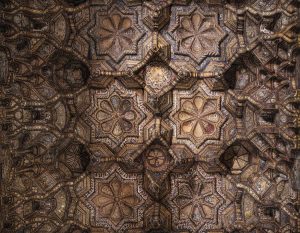
One of the oldest surviving wooden muqarnas is the Cappella Palatina in Palermo, Sicily. Image courtesy Aga Khan Museum.
Muqarnas include more than just one type of architectural decoration, he explains. In fact, the term covers a diverse range of connected variations and geometric proportions (muqarbas, for example, is a Spanish and North African variation; another is “arch-net” vaulting, more prevalent in Iran and central Asia, which can look like a network of intersecting lines pulled and stretched from above). Modern-day architects and designers have their own take on muqarnas, adapting the centuries-old concept to modern buildings and contemporary designs; there is an example in the Aga Khan Museum itself, inside the Nanji Family Foundation Auditorium.
While each muqarnas is unique and can reflect regional differences in artistic style and substance, Chagnon says they unify the architectural and visual world of Islam, having been replicated across many different countries and centuries. “We wanted to draw attention to this phenomenon, to capture the wonderful diversity and splendour of muqarnas as a journey through the Islamic world,” Chagnon describes. That journey and this exhibition evolved in conversation with artist and photographer Glenn McArthur, whose photographic project to document muqarnas took him to some 300 different sites in many different countries.
Explaining they are “essentially a decorative form”, muqarnas still serve a practical purpose, Chagnon says, by easing the visual transition from cuboid structure to spherical dome. Cut a ball in half, try to fit it on a box. Circle and square don’t match. So architects and building engineers have developed zones of transition between differing shapes, like corner squinches and small arches. “Muqarnas serve as a zone of transition in a beautifully designed multi-cell surface that is a seamless and elegant transition on the interior,” he says.
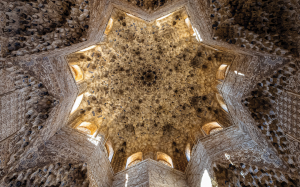
Inside the Alhambra palace, one of the most famous and well-preserved examples of Islamic architecture, in Granada, Spain. Image courtesy Aga Khan Museum.
Yet superseding even their practical value and aesthetic beauty, there is a symbolic theological significance, Chagnon and the exhibition imagery suggest: “They remind the viewer of the transience of creation, the intricacy and immensity of the cosmos. There’s a never-ending shifting of light and shadow when multi-cell muqarnas are illuminated from a nearby window or aperture,” Chagnon describes. “The movement is a reminder of transience, transition, of divine intervention.”
Just looking at muqarnas is itself an act of transition: between here and there, between now and then, between what is real and what is remembered.
Remembered, because while several of the earliest examples of muqarnas remain intact, many others have been damaged or destroyed amid conflict.
In civil war-torn Syria, numerous early structures featuring muqarnas have been lost in the fighting, particularly around Aleppo. In Iraq, Islamist extremists levelled muqarnas-decorated buildings, including one of the earliest known muqarnas-domed buildings.
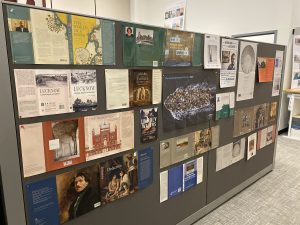
Book covers and other documentation on display at the Aga Khan Documentation Center are among many resources available.
(It was to document and describe this architectural loss that the Museum partnered with the Aga Khan Documentation Center at MIT; these added high-resolution archival photographs of now-lost muqarnas structures remind us of the fragility of art and the danger to historical monuments in conflict zones around the world.)
All the other images in the exhibition are by Toronto-based photographer Glenn McArthur, whose interest in muqarnas was triggered on a post-college European trip and a visit to Alhambra Palace in Spain; that started a multi-year personal journey to research and document muqarnas, one still underway quite recently.
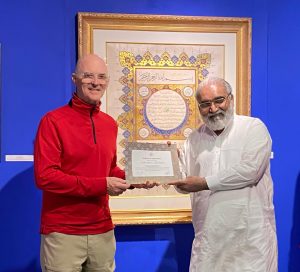
Toronto-based artist and photographer Glenn McArthur is recognized and awarded for his photographic documentation of muqarnas. Artist Instagram photo.
On a visit to Pakistan earlier this year, McArthur gave a talk at the 4th International Islamic Art Festival at the Museum in Lahore, where he was presented with a Certificate of Recognition for his on-going photographic work with muqarnas.
Architecture and art. Math and science. There is a zone of transition between them, and muqarnas are the bridge.
Their infinite intricacies evoke thoughts of fractal geometry and notions of ad infinitum scaling. Their repeating patterns and shapes blend two-dimensional outline and three-dimensional shape. Muqarnas show the interconnections among science, math and art. They can symbolize the mathematical proportions and the fractal geometry of natural organisms, like plants, animals and continental coastlines.
For example, in her research paper The Fractal Dimension of Islamic Architecture, lecturer Mai Abdelsalam, Doctor of Philosophy in Architecture at Alexandria University in Egypt, describes in some detail how and where fractal geometry exists, especially in muqarnas (she uses as her example the Al-Sultan Hassan Madrasa and Mosque in Cairo). Other researchers have identified what they call Islamic Geometric Patterns (IGPs) and how they fit it with anticipated developments in computer science, math, and technology.
Or with centuries-old principals that just happen to make for a smart walk through the park.
# # #
Muqarnas: Form and Light is on display in the Aga Khan Park until September 7, 2025; it is also part of the 2025 CONTACT Photography Festival, which runs May 1 to 31 in various Toronto locations.
-30-
More articles on Aga Khan Museum



